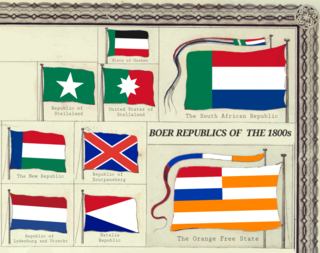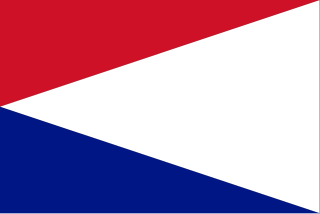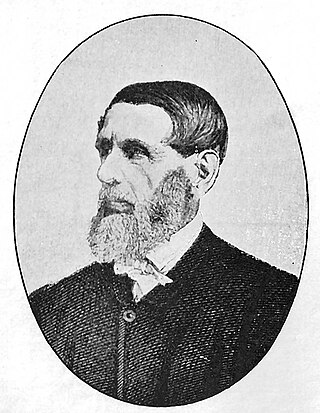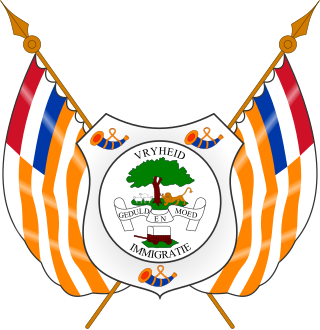
 Flag of the Natalia Republic
Flag of the Natalia RepublicThe flag of the Natalia Republic was the official flag of this short-lived South African state, which existed from 1839 to 1843.

 Flag of the Natalia Republic
Flag of the Natalia RepublicThe flag of the Natalia Republic was the official flag of this short-lived South African state, which existed from 1839 to 1843.
Emigrant Boers ('voortrekkers') from the Cape Colony established an independent state in 1839, on territory conquered from the Zulus. They named it 'Natalia'. It is uncertain what flag – if any – they flew at first, but on 24 December 1839 they raised a new flag at Port Natal (now Durban. The same flag was raised in the capital, Pietermaritzburg, in January 1840.
British forces invaded the republic in May 1842 and occupied Pietermaritzburg two months later. The flag was probably discontinued at that time or shortly afterwards. After three years of military occupation, the United Kingdom formally annexed Natalia, as 'Natal', in May 1844.
Andries Pretorius, former Prime Minister of the Natalia Republic, and his followers, arrived in Potchefstroom after the annexation of Natal to the United Kingdom and brought with him the flag which saw continued use in Potchefstroom until it was relinquished in 1858. [1]
The flag and its design passed into obscurity. They returned to public notice only after the South African Archives acquired the papers of Professor Ulrich Lauts in 1925. Back in 1847, Lauts had published a book (in the Netherlands) in which he described the flag as being in the colours of the Dutch flag (i.e. red, white and blue) and in the same order. "The white, however, stretches from a point in the middle of the hoist to the full width of the cloth at the end of the flag". [2] [3]
An article in a popular magazine in 1928 brought this description of the flag to the public's attention. [4] Illustrations based on it have been published in many articles and books since then.
The Voortrekkers youth organisation, founded in 1931, adopted the Natalia flag as its own. [5]
The Voortrekker Monument used the Natalia flag in its Cenotaph Hall.
The flag is generally made and depicted as rectangular, in the proportions 2:3. However, a contemporary painting of the flag, on a document dated 1842, which was found in the Algemene Rijksarchief in the Netherlands in 1953, shows a square flag. [6] [7]

The Boer republics were independent, self-governing republics formed by Dutch-speaking inhabitants of the Cape Colony and their descendants. The founders – variously named Trekboers, Boers and Voortrekkers – settled mainly in the middle, northern, north-eastern and eastern parts of present-day South Africa. Two of the Boer Republics achieved international recognition and complete independence: the South African Republic and the Orange Free State. The republics did not provide for the separation of church and state, initially allowing only the Dutch Reformed Church, and later also other Protestant churches in the Calvinist tradition. The republics came to an end after the Second Boer War of 1899–1902, which resulted in British annexation and later incorporation of their lands into the Union of South Africa.

Andries Wilhelmus Jacobus Pretorius was a leader of the Boers who was instrumental in the creation of the South African Republic, as well as the earlier but short-lived Natalia Republic, in present-day South Africa. The large city of Pretoria, executive capital of South Africa, is named after him.

The Natalia Republic was a short-lived Boer republic founded in 1839 after a Voortrekker victory against the Zulus at the Battle of Blood River. The area was previously named Natália by Portuguese sailors, due to its discovery on Christmas. The republic came to an end in 1843 when British forces annexed it to form the Colony of Natal. After the British annexation of the Natalia Republic, most local Voortrekkers trekked northwest into Transorangia, later known as the Orange Free State, and the South African Republic.

The flag of Cape Colony was the official flag of the Cape Colony from 1876 to 1910. It formed part of a system of colonial flags that was used throughout the British Empire.

Jacobus Nicolaas Boshof was a South African (Boer) statesman, a late-arriving member of the Voortrekker movement, and the second state president of the Orange Free State, in office from 1855 to 1859.

Dirk Van der Hoff was minister of the Nederduitsch Hervormde Kerk, one of the Dutch Reformed Churches in South Africa.

The flag of the Orange Free State was officially used from 1857 to 1902. It was superseded by the flag of the Orange River Colony.

The Flag of Transvaal was the official flag of the Transvaal colony in South Africa from circa 1903 to 1910. It formed part of a system of colonial flags that was used throughout the British Empire. It was superseded by the flag of the Union of South Africa.
Johan Arnold Smellekamp was a Dutchman who pioneered trade with the Boer Voortrekker states in South Africa and later became a civil servant, politician and law agent in the Orange Free State.

The KwaZulu-Natal Division of the High Court of South Africa is a superior court of law with general jurisdiction over the KwaZulu-Natal province of South Africa. The main seat of the division is at Pietermaritzburg, while a subordinate local seat at Durban has concurrent jurisdiction over the coastal region of the province. As of August 2013 the Judge President of the division is Chiman Patel.

The coat of arms of the Orange Free State was the official heraldic symbol of the Orange Free State as a republic from 1857 to 1902, and later, from 1937 to 1994, as a province of South Africa. It is now obsolete.

The coat of arms of the Transvaal was the official heraldic symbol of the South African Republic from 1866 to 1877 and again from 1881 to 1902, and later the symbol of the Transvaal Province from 1954 to 1994 in a simplified form. It is now obsolete.

The flag of Goshen was the official flag of the short-lived South African territory of Goshen from 1883 to 1885. It is currently used in the Cenotaph Hall of the Voortrekker Monument.

The flag of Natal was the official flag of the South African colony of Natal from 1870 to 1910. It formed part of a system of colonial flags that were used throughout the British Empire.

The flag of the Nieuwe Republiek was the official flag of this short-lived South African state from 1884 to 1888.

The flag of the Orange River Colony was the official flag of the Orange River Colony in South Africa from 1904 to 1910. It formed part of a system of colonial flags that was used throughout the British Empire. It was superseded by the Flag of the Union of South Africa.

The South African Republic, which existed from 1852 to 1877, 1881 to 1902, and 1914 to 1915, used two flags: (1) the so-called 'Vierkleur' from 1857 to 1874, and again from 1875 to 1877 and 1881 to 1902, and (2) the so-called 'Burgers Flag' from 1874 to 1875. They were superseded by the flag of Transvaal. The Vierkleur was also used by the South African Republic declared in 1914 during the Maritz Rebellion, which lasted into February 1915.
The following is a timeline of the history of Pietermaritzburg. It is part of the Msunduzi Local Municipality in the Umgungundlovu District Municipality, KwaZulu-Natal province, South Africa.
The Pietermaritzburg Reformed Church was a congregation of the Dutch Reformed Church in South Africa (NGK) in Pietermaritzburg, the capital of KwaZulu-Natal, but after the sale of the congregation’s downtown building, its centre shifted to what is now Howick. It was the first congregation founded by Voortrekkers after they left Cape Colony and the 25th oldest congregation in the NGK. The congregation’s membership, however, declined by around two-thirds, from 752 in 2000 to 256 in 2015.